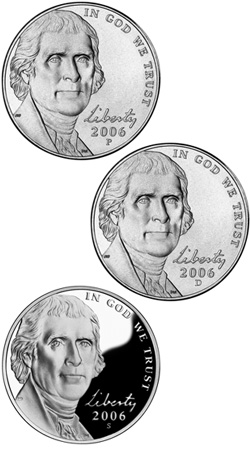Mint marks are letters that identify where a coin was made. They hold the maker responsible for the quality of a coin. When the U.S. used precious metals such as gold and silver to make circulating coins, a commission evaluated the metal compositions and quality of coins from each of the Mint facilities. The evaluations ensured that each facility produced coins to the correct specifications.
 Philadelphia was the only branch in operation in the Mint’s earliest years, so identifying the sources of a coin was not necessary. A March 3, 1835 Congressional Act established mint marks in the United States, along with the first Mint branches. When the Mint branches in Charlotte, Dahlonega, and New Orleans opened in 1838, mint marks made their first appearance on U.S. coins. However, the practice of not identifying Philadelphia’s coins continued even after the first branches were established.
Philadelphia was the only branch in operation in the Mint’s earliest years, so identifying the sources of a coin was not necessary. A March 3, 1835 Congressional Act established mint marks in the United States, along with the first Mint branches. When the Mint branches in Charlotte, Dahlonega, and New Orleans opened in 1838, mint marks made their first appearance on U.S. coins. However, the practice of not identifying Philadelphia’s coins continued even after the first branches were established.
This changed in 1942. When nickel was removed from five-cent coins during World War II, the “P” mint mark first appeared on coins produced in Philadelphia. The mark’s position also moved from the right of Monticello to above the dome to indicate the new metal composition. After the war, when use of the regular alloy resumed, the mint mark returned to its former position and the Mint no longer used Philadelphia’s “P.”
In 1979, the Susan B. Anthony dollar coin was introduced. Once again, the “P” mint mark appeared. The following year, the “P” appeared on all of the denominations except the cent, which still holds true today.
The table below lists the mint marks for each of the Mint’s current and historic facilities, and the dates they used the mark.
| Mint Branch | Mint Mark | Years Mark Used |
|---|---|---|
| Carson City (NV) | CC | 1870-1893 |
| Charlotte (NC) | C | 1838-1861 |
| Dahlonega (GA) | D | 1838-1861 |
| Denver (CO) | D | 1906-Present |
| New Orleans (LA) | O | 1838-1861, 1879-1909 |
| Philadelphia (PA) | P | 1942-45, 1979-Present |
| San Francisco (CA) | S | 1854-1955, 1968-Present |
| West Point (NY) | W | 1984-Present |
Mint Mark Facts
- No mint marks appeared on circulating coins from 1965 to 1967. The Coinage Act of 1965 eliminated mint marks to discourage collecting while the Mint worked to meet the country’s coinage needs.
- Mint marks were placed on the reverse of coins until 1968 when they moved to the obverse.
- The San Francisco Mint made circulating coins with the “S” mint mark from 1854 to 1955. After that, they produced “S” circulating coins from:
- 1968-1974: pennies
- 1968-1970: nickels
- 1979-1981: dollars
- In 1968, proof coin production moved from the Philadelphia Mint to San Francisco and proof coins gained the “S” mint mark.
- The West Point Bullion Depository made circulating pennies from 1973 to 1986 and circulating quarters in 1976 to 1979. The San Francisco Mint also produced circulating pennies around this time. These coins did not have mint marks so that they couldn’t be distinguished from Philadelphia coins.
- In 2017, the “P” mint mark appeared for the first time on circulating pennies. This change was only for the 2017 issued cents, in honor of the U.S. Mint’s 225th anniversary.
- In 2019, the “W” mint mark appeared for the first time on a circulating coin. The West Point Mint produced 10 million quarters in the 2019 America the Beautiful Quarters Program.
Mint Marks on Medals
 Most medals don’t have mint marks. The Philadelphia Mint makes Congressional Gold Medals and their bronze duplicates, Presidential Medals, and most others. But for certain numismatic silver medals, other Mint facilities may help. The Mint places the mint mark on some of these medals for marketing reasons. The mark can be on the obverse or reverse side, depending on how it fits into the design.
Most medals don’t have mint marks. The Philadelphia Mint makes Congressional Gold Medals and their bronze duplicates, Presidential Medals, and most others. But for certain numismatic silver medals, other Mint facilities may help. The Mint places the mint mark on some of these medals for marketing reasons. The mark can be on the obverse or reverse side, depending on how it fits into the design.
Mint Marks on Dies
The Mint adds mint marks to the master hub, the first stage of the die making process. The Philadelphia Mint makes a master hub for each facility that will strike the coin.


